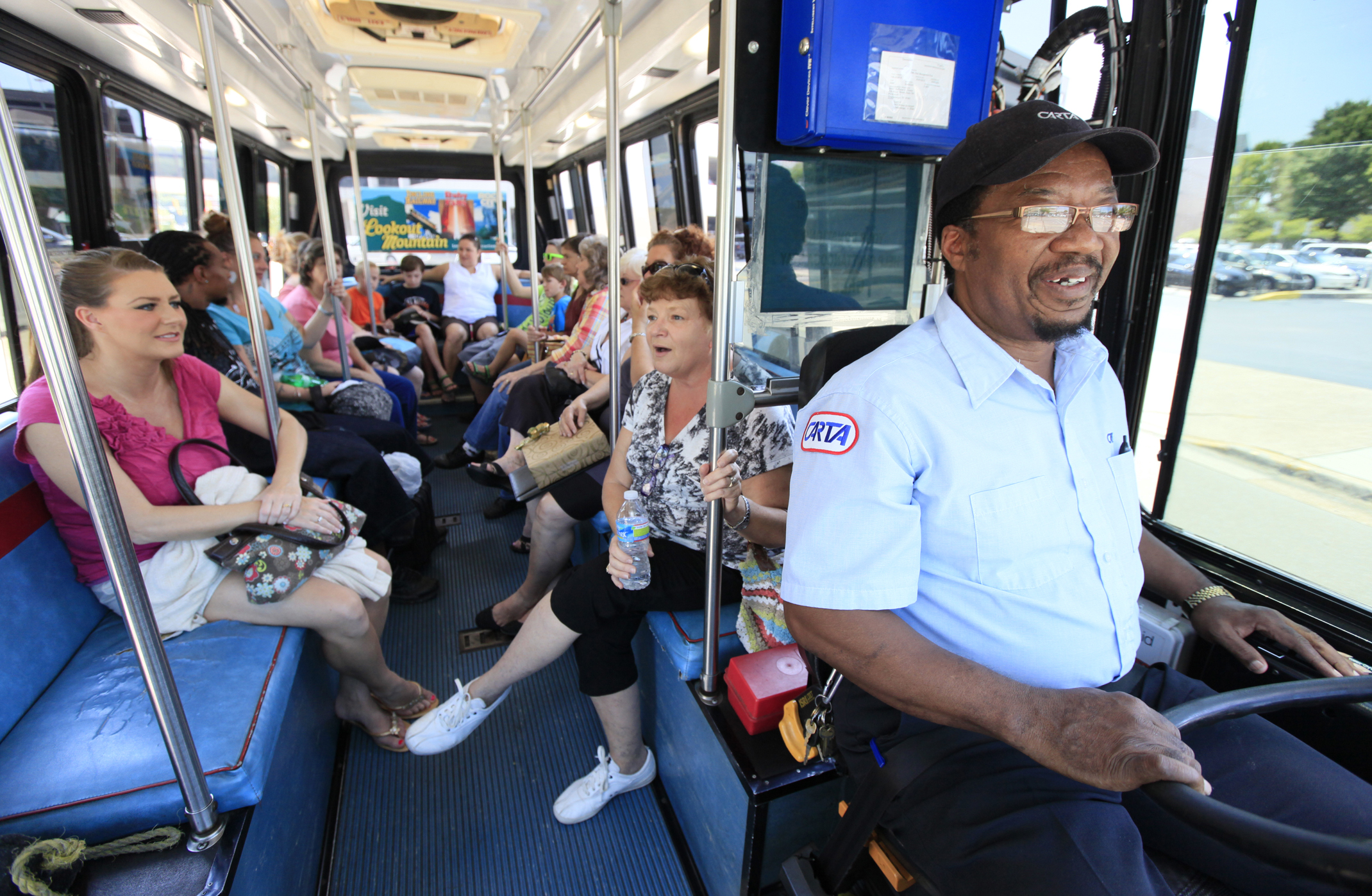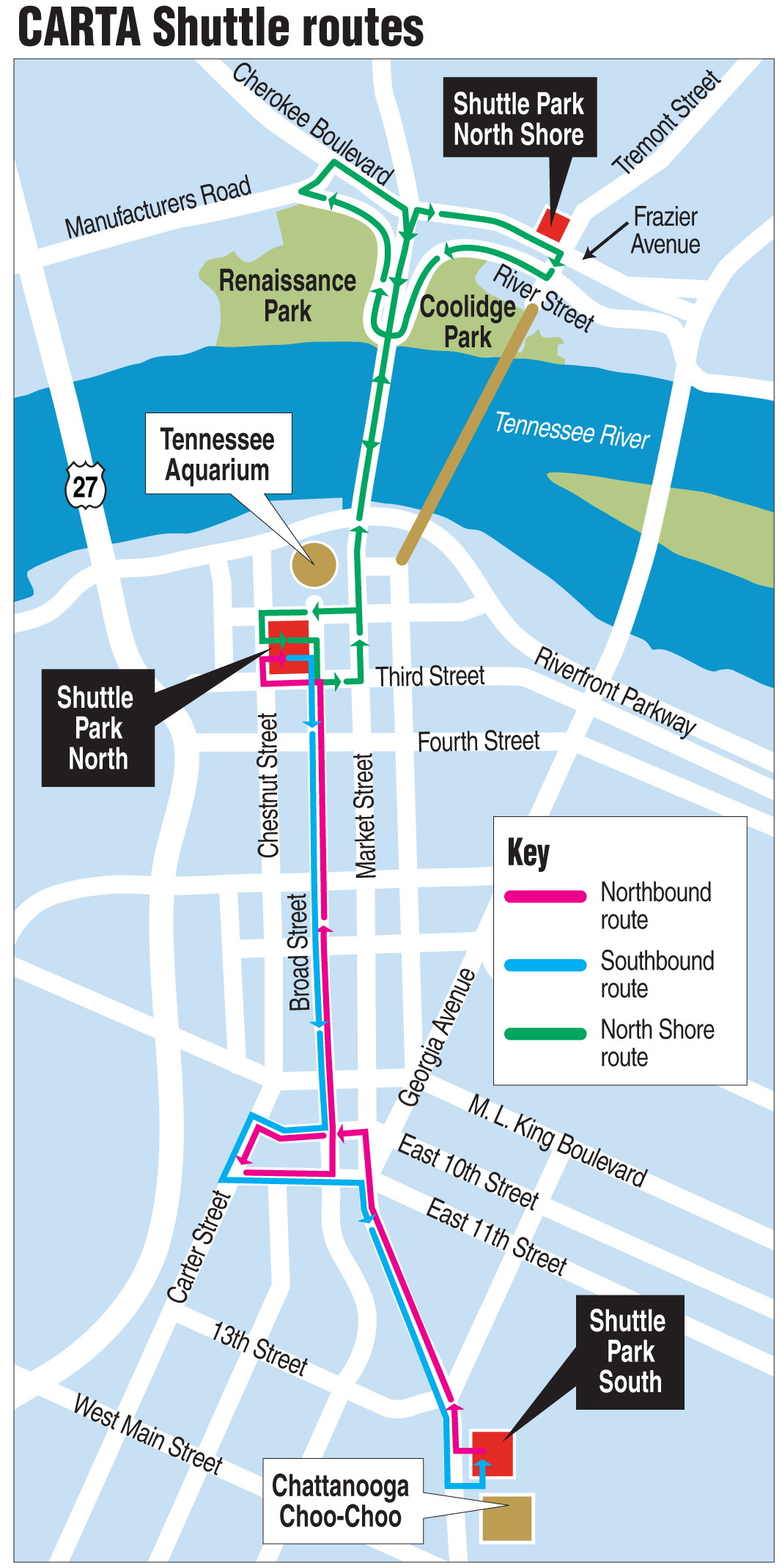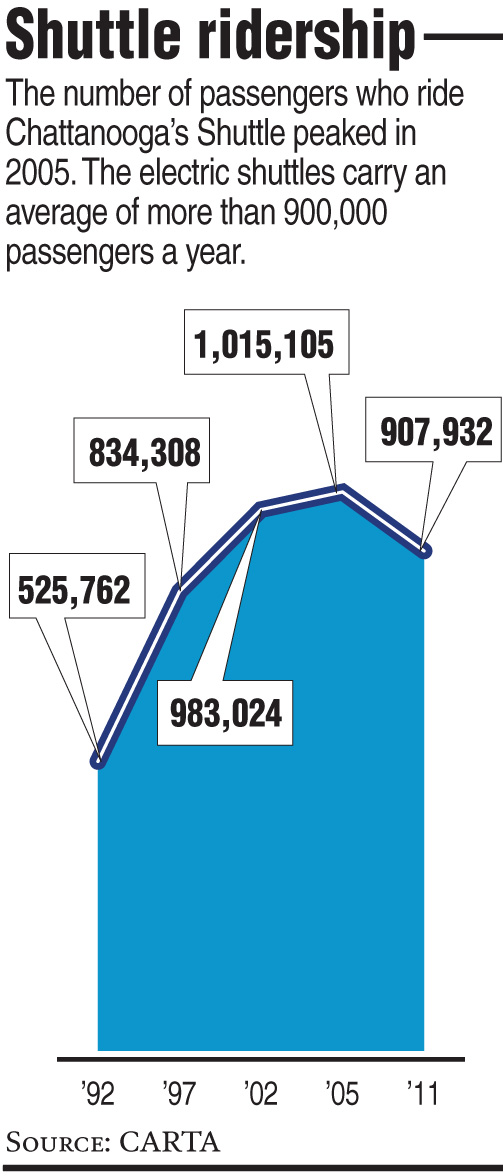BY THE NUMBERS969,000: Shuttle trips to the Tennessee Aquarium483,000: Gallons of diesel fuel saved in 20 years194,000: Pounds of tailpipe emissions savedSource: CARTA
Alex Volz, of California, rode Chattanooga's shuttle with his niece last week to get around downtown.
The preschooler gets excited about riding the free, all-electric buses, even learning the names of drivers, he said.
"It keeps the public in public transportation," Volz said about the shuttles.
As the city's shuttle system turns 20 years old today and marks the carrying of 16.9 million passengers, officials are looking at expanding the service.
CARTA is studying adding east-west routes to complement its north-south service. New runs may make sense because of growth in the Southside, new development on Main Street and a desire to better tie UTC to the central city, CARTA officials said.
"It's always been a goal to expand," said Tom Dugan, CARTA's executive director.
The public transit system also plans to take the shuttle's battery technology and put it on some of its regular fixed-route service with the help of a $2.8 million federal grant.
Linking A Linear Downtown
The shuttle's creation two decades ago arose in part to find a way to link the city's long, narrow downtown and its two linchpins -- the fledgling Tennessee Aquarium and the Chattanooga Choo Choo.
Attorney Rick Hitchcock, a former CARTA board chairman, said the initial idea was to build a fixed-rail, trolleylike system. He said CARTA even hired a company to use a metal detector to locate streetcar tracks with the idea of potentially rehabilitating the old lines.
The agency ultimately gave up on that idea. Steve Jett, CARTA's current chairman, said officials decided against locking into a fixed route.
"Even if it was right at the time, it might not be in five or 10 years," Jett said.
The decision was made to shift to a rubber-tire model. But at that time diesel bus technology tended to be loud, inefficient and smoky. Planners hit on the idea of electric vehicles and partnered with local businessman Joe Ferguson to create Advanced Vehicle Systems, which would develop and build electric buses. Some of the buses in the 18-vehicle fleet were built by AVS.
Developer Bill Sudderth, former head of the nonprofit River City Co., said the aquarium was projected 20 years ago to bring a lot more people and cars into the central city, and that's where the shuttle helped.
One of the aims was to keep streets unclogged and get people out their cars, he said.
Hitchcock said city leaders wanted a downtown shuttle service that was inviting to riders.
"What we thought was important was something that was clean, quiet ... and had a low floor and was an experience to itself," he said. They also wanted high frequency, with buses coming by about every five minutes, Hitchcock said.
One of the questions was how to pay for the service, officials said. It was a time when property owners were razing downtown buildings for surface parking.
"Developers weren't doing structured parking without subsidies," Hitchcock said. "[Surface parking lots] didn't produce any taxes to speak of. They certainly didn't produce any jobs to speak of."
Officials decided to leverage $16 million in federal grant money to build three parking garages. Money paid for parking supported the shuttle.
Shuttle ridership took off, hitting 525,000 passengers in its first nine months and more than 1 million in 2005. Last year, ridership was above 900,000, CARTA figures show.
Officials believe the shuttle also has aided downtown redevelopment.
Hitchcock noted that Carmike Cinemas built the first downtown movie theater in 50 years when it constructed the Bijou on the ground floor of CARTA's north parking garage.
Sudderth said the shuttle helped convince him to develop the mixed-use Jack's Alley project downtown. He said the shuttle provided a transportation connection for Jack's Alley patrons between Market and Broad streets.
FUTURE EYED
Dugan said shuttle ridership today is split about 50-50 between tourists and residents.
Having no fare is a big key, officials said.
"Free is critical," Jett said.
Other cities that have implemented fares as low as 75 cents have seen drastic drops in shuttle ridership, officials said.
Parking revenue from CARTA-operated garages, meters and downtown lots ill pay the shuttle's operating expenses next fiscal year and help pay for the expansion, Dugan said.
He said CARTA is working with the city in evaluating where the shuttle might go next. Manufacturers Road is likely, and possibly the planned national park on Moccasin Bend.
East-west service on the Southside also has potential, Dugan said.
"Main Street is exploding," he said.
Hitchcock said it's logical to consider serving UTC, Fort Wood and potentially Erlanger.
CARTA officials said they don't expect to change the formula of free fares and electric power in the future.
However, Dugan said CARTA is looking at using the $2.8 million federal grant to buy three or four new buses for its regular fixed-route service. He said electric buses could be used for short, fairly flat routes such as to St. Elmo, Golden Gateway or East Lake. Some of the money would pay for innovative battery recharging equipment placed under street pavement.
The shuttle system hasn't been without bumps over the years.
AVS, which was run by Ferguson and Hitchcock, went out of business. Money problems spurred talk of ending the shuttle four years ago, and the parking decks aren't always full, according to officials. The North Shore deck especially is lagging, Dugan said.
The vehicles are aging -- the youngest was built in 1997, and one shuttle bus sports more than 200,000 miles.
Dugan said CARTA has grant money to replace six buses, with bids likely going out in early 2013.
Mary Anne White, of Melbourne, Fla., who was visiting the city with her husband last week, said the shuttle was one of the things that appealed to them about the city.
"We don't have to rent a car," she said.


